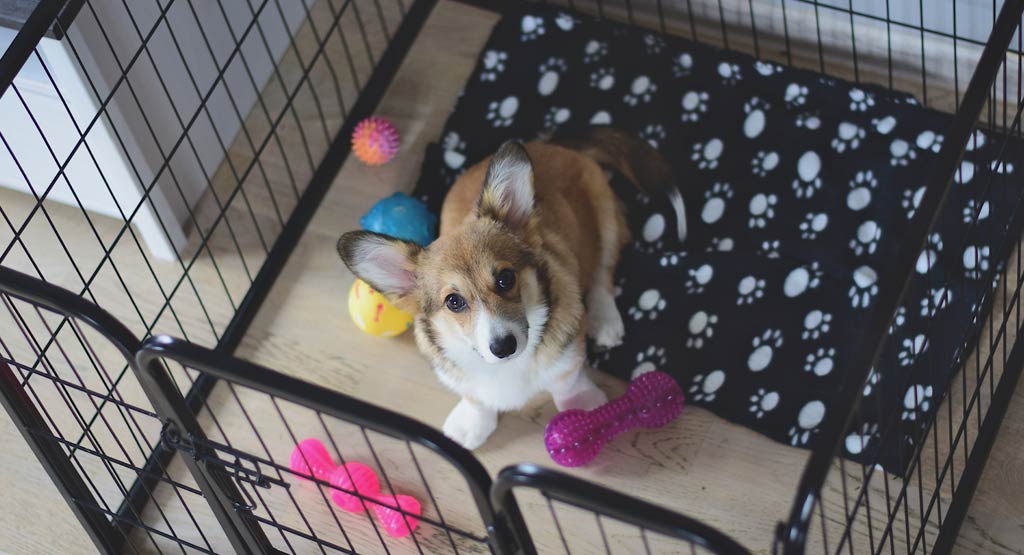
Puppies truly are often the most loyal and loving pets that a person could have. Because of this, no one ever wants to leave them! Unfortunately, it’s just unrealistic to think that you can be there with your furry friend every moment of the day. You’ve got work to do so you can buy him more treats, after all.
Young puppies do not need to be left in the whole house alone all day. To crate train a puppy, you must start with a confined, safe space like a crate for them to go when you can’t be there. It can be frustrating at first – puppies don’t especially like to be contained. However, this is for his safety, and it needs to be done.
Don’t give up hope. Crate training your puppy is easier than it seems! Follow this four-step guide, and you can get the job done quickly and efficiently.
Step 1: Introduce the puppy to his new space
You want your puppy to associate his crate with relaxation and happiness instead of dread; it should be a safe place. He will be more apt to go there without fussing or whining if you slowly introduce him to the environment without making him feel like he is being punished.
- Place the dog crate wherever your family is most often together. This is usually the living room. This way, he feels included and safe because he knows you are there to protect him.
- Put something soft, warm, and comforting in the crate like a blanket or pillow.
- Bring the puppy near the crate, speaking to him in soothing tones all the while.
- Put the pup’s treats or food in the opening of the crate. This will encourage him to go inside and eat. If he doesn’t like treats, try a favorite toy instead.
- If he doesn’t go at first, try placing the treats near the opening instead of inside. Be patient until he goes all the way in for the food. Never try and force him out of frustration; this creates fear.
Step 2: Feeding inside the crate
Puppies love to eat just like all babies do! This is why you should start regularly feeding yours inside of the crate. Food is associated with happiness and satisfaction. Link that feeling to his crate, and he will not be so apprehensive anymore.

- Only place the food bowl as far in as the puppy is comfortable with. Over time, you can start placing it further and further back.
- Once he is fully inside the crate and eating, close the door gently.
- After feeding time is done, immediately open the crate door and let your pup out. Do not let him think that he’s been tricked.
- Gradually increase the time you leave the door closed. Go slow and steady; too fast and your puppy will begin to panic.
Step 3: Teach him to stay
After the puppy has become acclimated to the crate through feeding times and will stay in without panicking, you can start to condition him to stay for a while.
- Call your puppy over to the crate. Give him a treat and say a command word like “kennel.”
- Once he gets in, give him another treat and shut the door.
- Stay in the room with the pup at first. Try to be quiet, so he stays calm.
- Leave the room after spending some time relaxing with him and come back after a few minutes. Let him out when you get back.
- Start with small increments of 10 minutes and gradually increase the time that your pup is in his crate. Do not let him out when he whines. If you do this, your devious little fur baby will start to think that whining lets him get out of the situation he does not like. This sets a bad precedent.
- Once he can stay for around a half hour without being too upset, you can start leaving him in the crate while you go out on short errands.
Step 4: Leave your puppy alone
Crate training a dog is a scary and emotional step for many dog owners, but it is one that is necessary for letting a puppy adapt to being in his crate alone.
- Put your dog or puppy in his crate with your usual training method shortly before you leave. This should be between 5 and 20 minutes before you head out.
- When you shut the door and say goodbye, do not get too emotional or stay for too long. You are working him up by doing this, making the time apart harder than it needs to be. Reward him for being good and go.
- When you come back from your errand, let him out without making a big fuss.
- Repeat the process when you go places and when you don’t. This will let your pup know that being in a crate does not necessarily mean that he will be alone, creating less fear and resistance when you do leave. It may even help avoid separation anxiety.
Things to Remember
You need to know a few things about crate training puppies that others may not tell you. Following these simple rules will make all the difference between a sad and lonely puppy and a happy one.
- Never use force to put a puppy in a crate. These aggressive actions will do nothing but scare him, and this will make training much harder. If you want to get it done effectively, be patient and gentle.
- If you have a full-time job and are away for longer periods, you can’t expect your puppy to be in a crate for 8 hours per day. After a certain period of time, it becomes cruel to do this. Puppies can’t hold their bladders or bowels for very long. The maximum time they should be in their crate is 4 hours. You need to either take him out on your lunch break or find a pet sitter who will come by and help and let them have a potty break.
- Keep the crate clean. You would not want to be stuck in a filthy, stinky room for any length of time. Why should a puppy have to be?
- Don’t rush the training. It can take several weeks for your pup to get used to a crate, and that is perfectly normal. Rushing him is counterproductive because again, you are only instilling fear in him.
Be kind, patient, consistent, and gentle. In good time, your puppy will learn that his crate is a safe haven instead of a jail, and he will stop giving you those heartbreaking puppy dog eyes when you leave. Stay strong and don’t give in to the whining, no matter how sad it makes you. Be a super pet parent and crate train as soon as you can!
Reference
Bringing a new family addition into the home is extremely exciting! Becoming a new puppy parent comes with a ton of new joys, challenges and responsibilities. PupBox was created to help new puppy parents like yourself, by providing all of the toys, treats, accessories and training information you need, when you need it. CLICK HERE to learn more about PupBox.

And remember, puppyhood is fast and is gone before you know it. Make sure to savor the time when your pup is young, and take lots of pictures along the way!
